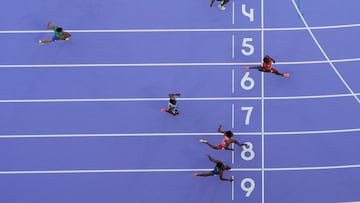Why does Paris 2024 Olympics athletics track have nine lanes instead of eight?
Regular viewers of athletics will be conscious that there are normally eight runners competing, so why would an extra lane be required?

The athletics competition at Paris 2024 began last Friday at the Stade de France, the Olympic stadium that was prepared to host rugby-7s, where France won in the men’s category and New Zealand in the women’s. The stadium is also host to the highly anticipated track and field events, including sprints, hurdles, long jump, triple jump, and strength events like javelin, hammer, and discus throws, among many others. In fact, 46 out of 48 events will ultimately take place inside the stadium, with only the men’s and women’s race walking events having been held outside. The novelty in these Olympic Games, though, is the purple colour of the athletics track, and that it has nine lanes.

IAAF-approved tracks must traditionally have 8 lanes. The peculiarity of the Olympics is that they feature an extra one with the adjustment aiming to better manage ties or possible reclassification of an athlete. Alain Blondel, head of Athletics at Paris 2024, explained: “In case of a tie, if there are disqualification issues between the semifinals and the final in races like the 400 meters or 800 meters, this lane will allow us to reclassify an athlete without resorting to a draw, which is really difficult for athletes.”
Why is the athletics running track purple?
The Italian company Mondo is responsible for manufacturing the athletics track used in the Olympic Games. Traditionally, athletics tracks are dark red. This colour purple was chosen because it absorbs the least amount of ultraviolet rays from the sun, allowing the outer lanes to maintain a good appearance and not deteriorate over time.
Related stories
The Parisian organisers aimed to differentiate themselves from previous Games. In Rio 2016, the track was blue. This choice was supposed to improve athletes’ concentration and reduce visual fatigue for spectators, but it was mainly for aesthetic reasons. Paris decided that this year the track would be dyed lavender purple.
The purple track 💜
— Paris 2024 (@Paris2024) May 21, 2024
No more red-brick clay color, our Olympic & Paralympic track is going purple for the first time ever in the Stade de France. This new one is supplied by Mondo, Official Supporteur of #Paris2024. Records are made to be broken. Hope this track will help ⚡ pic.twitter.com/0Pr1EGHo7a
The track has a thickness of 135 milimeters and was manufactured with sustainable development criteria in mind. It is made with 50% renewable non-fossil products, which help sustainability, make them more durable, and therefore have a longer lifespan. “Mussel shells are used in its composition,” explained Blondel.
Complete your personal details to comment